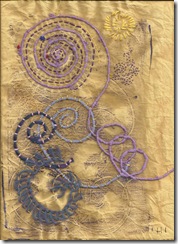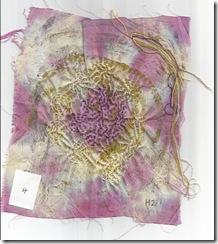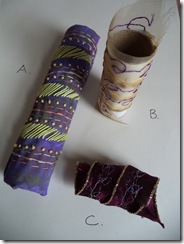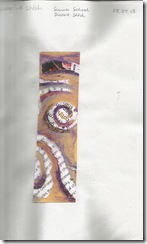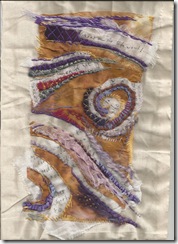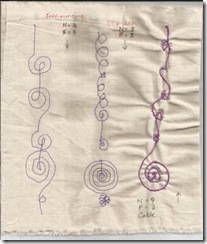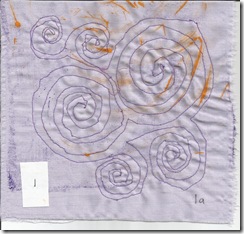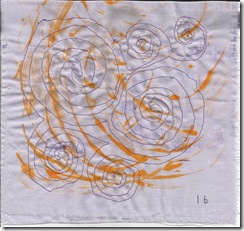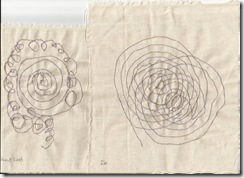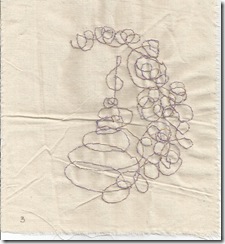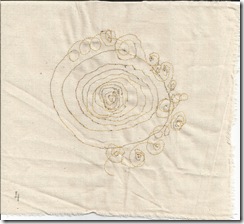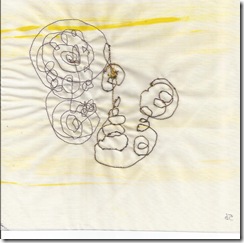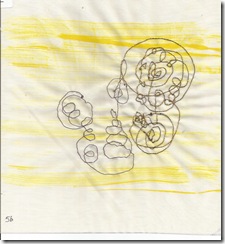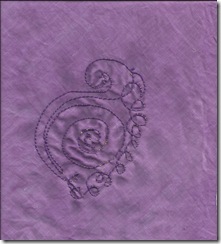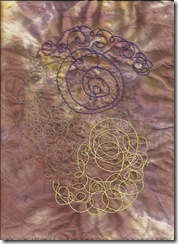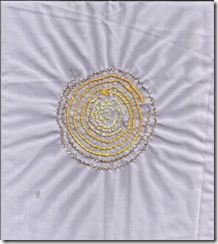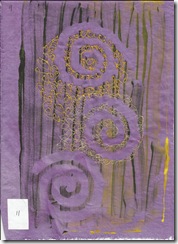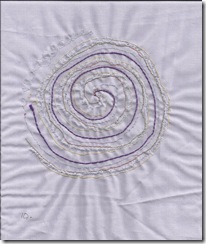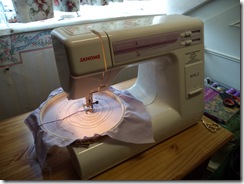This chapter is divided into two sections
Section A. Hand stitchery
Section B. Machine Stitchery
Here are presented the samples, with just a note to accompany each.
Most of the work was stitched into hand dyed fabrics, but some samples especially in Section B included plain calico or commercial coloured fabrics, when experimenting with stitch techniques.
Health & Safety, techniques, stitches, fabrics and threads used were listed in my file.
Section A. Hand stitchery
H 1 A sampler showing hand dyed yellow cotton with darker purple mono-print, large spiral with several rows from central point,tiny continuous spirals, yellow or purple, series of overlapping spirals in shades of wool couched indicating background, middle and fore-ground, medium yellow spiral, all producing a spiralling network.
Helped by the mono-printing was pleased by the depth and movement in this piece. Like the idea of keeping some of the mono-printing free of stitch, but could add more to it (possibly machine stitchery).
H 2 Using Sample 4 of the mono-prints Series of spirals in purple and different shades of yellow.
Particularly like the texture from gathering the running stitches, and the patterns from the spirals being close together. Feel this would be ideal for making buttons.
H 3 Commercially random dyed purple and yellow cotton showing back stitch, running stitch, wide stem stitch and french knots, which I then wrapped around a cardboard core. Inspired by the column on a harp. (Shown as A). When flat the pattern was depicting a spiral column in 2-D, but by wrapping around the card prefer the 3-D effect.
H 4 Stitched ribbon Back stitched continuous spirals along ribbon ( Shown as B)
Another sample: At the Summer school (Sue Dove’s workshop) using music as inspiration from part of a larger piece with text and oil pastels on orange card, I then enlarged and depicted the piece in stitch. The dyed fabric was wet wipes used to clean off paint. It was great trying to generate the original paper version into stitch, using different threads and stitches. The text was duplicated using a felt tip pen on muslin from musical quotes. The result I feel has earthy almost aboriginal elements.
The card was 5cm x 18 cm. The finished piece 14 cm x 26 cm on calico
Section B. Machine Stitchery
The machine was set up for free machine embroidery as outlined in my file. Initially I worked without a hoop as seen in the first three samples, but found it more effective using a hoop
The samples in this section include free running stitch, whip stitch, cable stitch and zigzag stitch.
The first on calico shows the three main stitches, without a hoop
Samples 1a and 1b on purple cotton with mono-print 1, show upper side and reverse of continual spirals, free running stitch (18cm x 18cm)
Samples 2a and 2b on calico show two threads in the needle, 2a without a hoop, 2b with a hoop (18cm x 18cm each)
Sample 3 on calico, same thread as 2, with a hoop (18cm x 18 cm). To ensure the fabric is taut in the hoop need to use a larger size piece of fabric. However this is quite a lively piece showing different spirals.
Sample 4 on calico, with a hoop showing whip stitch. I hoped the variegated purple thread in the bobbin would have shown up better. Whip stitch was achieved but this is rather a subtle coloured piece (18cm x 18 cm)
Samples 5a and 5b Whip stitch which came out as cable stitch. Top and reverse of the piece are shown here (25cm x 25cm) Design smaller, moving the hoop to fit.
Sample 6 on linen Cable stitch (25cm x 25 cm) Looks like a shell or snail!
Sample 7 on random dyed fabric shows a variety of stitches and mixed threads. Plenty of overlapping giving movement and depth to the piece (20cm x 26cm). Like this the best so far!
Sample 8 on cotton Mostly cable stitch and zigzag with different threads. This continuing spiral could grow or be left this size. Worked area has a diameter of 10cm. Interesting gathered effect.
Sample 9 on purple dyed cotton with mono-print 11. Used whip stitch, continuous small spirals in complementary colours to infill the negative space from the masks. Feel this was effective. (28cm x 20cm) Later photographed a piece of chiffon with the same mono-print overlaying this sample to give another dimension.
Sample 10 on purple poly cotton. This was made up with a series of different stitches each row starting at the same central position, finishing with a sequence of spirals. Used running stitch, running stitch with two needle threads, whip stitch, cable stitch and zigzag stitch and complementary colours. (Diameter of 15cm)
Finally I tried to machine stitch some ribbon, the sort that has fine wire structure in order to give a 3-D effect (See C on the final hand stitched sample)
This next photograph shows the machine set up, working on Sample 10
I am conscious that I have not combined hand and machine stitching, but appreciate that this would give another dimension to the work.
